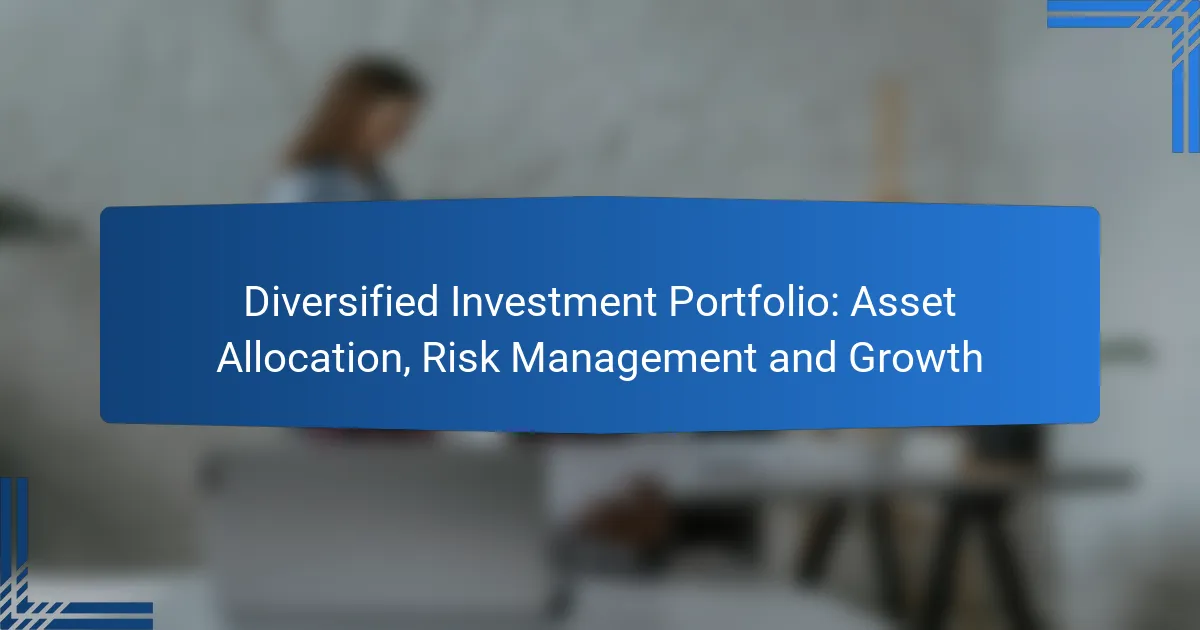A diversified investment portfolio is essential for managing risk and enhancing potential returns in the UK market. By strategically allocating assets across various categories such as stocks, bonds, and cash, investors can balance their risk and reward according to their financial goals. Effective risk management further safeguards capital while pursuing growth, making diversification a key strategy for long-term financial health.

How to build a diversified investment portfolio in the UK?
Building a diversified investment portfolio in the UK involves spreading investments across various asset classes to manage risk and enhance potential returns. This strategy helps mitigate the impact of market volatility on your overall financial health.
Asset classes to include
A well-diversified portfolio typically includes a mix of asset classes such as equities, bonds, real estate, and cash. Equities can provide growth potential, while bonds often offer stability and income. Real estate can serve as a hedge against inflation, and cash provides liquidity for immediate needs.
Consider including international assets to further diversify your exposure. For instance, investing in foreign stocks or global bond funds can reduce risk associated with domestic market fluctuations.
Steps to diversify
Start by assessing your risk tolerance and investment goals to determine the right mix of assets. A common approach is to allocate a percentage of your portfolio to each asset class based on your financial objectives and market outlook.
Next, regularly review and rebalance your portfolio to maintain your desired asset allocation. This may involve selling assets that have performed well and buying those that have underperformed, ensuring your portfolio remains aligned with your strategy.
Common mistakes to avoid
One common mistake is over-concentration in a single asset class or sector, which can increase risk significantly. Ensure you are not overly reliant on one type of investment, such as technology stocks, which can be highly volatile.
Another pitfall is neglecting to adjust your portfolio as your financial situation changes. Life events such as retirement, job changes, or market shifts should prompt a reassessment of your asset allocation to ensure it continues to meet your needs.

What is asset allocation?
Asset allocation is the process of distributing investments across various asset categories, such as stocks, bonds, and cash, to balance risk and reward based on an investor’s goals and risk tolerance. This strategy helps in managing risk while aiming for growth over time.
Definition of asset allocation
Asset allocation refers to the method of dividing an investment portfolio among different asset classes. The main goal is to optimize the risk-return profile by investing in a mix of assets that respond differently to market conditions. For example, a portfolio may include equities for growth, fixed income for stability, and cash for liquidity.
Investors typically use a percentage-based approach to determine how much to allocate to each asset class. A common strategy might involve a higher percentage in stocks for younger investors seeking growth, while older investors may prefer a larger allocation to bonds for income and preservation of capital.
Importance of asset allocation
Asset allocation is crucial because it directly impacts the overall performance and risk level of an investment portfolio. By diversifying investments across various asset classes, investors can reduce the impact of poor performance in any single category. This strategy helps in achieving more stable returns over time.
Moreover, effective asset allocation can help investors align their portfolios with their financial goals, whether it’s saving for retirement, funding education, or purchasing a home. Regularly reviewing and adjusting the asset allocation in response to market changes and personal circumstances is essential for maintaining an optimal investment strategy.

How does risk management work in investment?
Risk management in investment involves identifying, assessing, and prioritizing risks to minimize their impact on an investment portfolio. It aims to protect capital while seeking growth through strategic asset allocation and diversification.
Types of investment risks
Investment risks can be categorized into several types, including market risk, credit risk, liquidity risk, and operational risk. Market risk refers to the potential losses due to fluctuations in market prices, while credit risk involves the possibility of a borrower defaulting on a loan. Liquidity risk occurs when an asset cannot be quickly sold without a significant loss in value, and operational risk stems from failures in internal processes or systems.
Understanding these risks is crucial for investors. For example, market risk can be mitigated through diversification across different asset classes, while credit risk may be managed by investing in high-quality bonds. Each type of risk requires specific strategies to effectively manage potential losses.
Risk management strategies
Effective risk management strategies include diversification, asset allocation, and the use of hedging techniques. Diversification involves spreading investments across various asset classes to reduce exposure to any single risk. Asset allocation refers to the strategic distribution of investments among different categories, such as stocks, bonds, and real estate, based on individual risk tolerance and investment goals.
Hedging techniques, such as options and futures contracts, can also protect against adverse price movements. For instance, an investor might use options to limit potential losses on a stock position. Regularly reviewing and adjusting these strategies is essential to align with changing market conditions and personal financial objectives.

What are the benefits of a diversified portfolio?
A diversified portfolio offers several advantages, including the potential for higher returns and a reduction in volatility. By spreading investments across various asset classes, investors can balance risks and enhance overall performance.
Potential for higher returns
Diversification can lead to higher returns by allowing investors to tap into multiple growth opportunities. When one asset class underperforms, others may excel, helping to maintain or even increase overall portfolio value.
For instance, a mix of stocks, bonds, and real estate can provide access to different market segments. Historically, equities have offered higher returns compared to fixed income, but they also come with greater risk. A balanced approach can help capture gains while managing exposure to downturns.
Reduction of volatility
A diversified portfolio tends to experience less volatility compared to a concentrated one. By holding a variety of assets, the impact of poor performance in any single investment is minimized, leading to a smoother overall return profile.
Investors can consider including assets like commodities or international stocks to further reduce volatility. For example, during economic downturns, certain sectors may perform better than others, providing a buffer against market fluctuations. Maintaining a well-rounded portfolio can help investors weather financial storms more effectively.

How to assess your risk tolerance?
Assessing your risk tolerance involves understanding how much risk you are willing to take with your investments. This self-evaluation helps you determine the right asset allocation for your diversified investment portfolio.
Risk assessment questionnaires
Risk assessment questionnaires are tools designed to gauge your comfort level with various investment risks. They typically include questions about your investment goals, time horizon, and financial situation, helping to categorize your risk profile as conservative, moderate, or aggressive.
Many financial institutions offer these questionnaires online, making it easy to complete them at your convenience. After answering the questions, you will receive insights into your risk tolerance, which can guide your investment decisions.
Factors influencing risk tolerance
Several factors influence your risk tolerance, including age, financial situation, investment goals, and market experience. Younger investors often have a higher risk tolerance due to a longer time horizon to recover from potential losses, while older investors may prefer safer investments to preserve capital.
Your current financial situation, including income, savings, and obligations, also plays a significant role. Those with stable incomes and substantial savings may be more willing to take risks compared to individuals with tighter financial constraints.
Additionally, your investment goals—such as saving for retirement or a major purchase—can affect your risk appetite. Understanding these factors can help you make informed decisions about your investment strategy and asset allocation.

What tools can help with portfolio management?
Effective portfolio management tools can streamline the investment process, enhance tracking, and improve decision-making. These tools include investment platforms and portfolio tracking applications that cater to various needs and preferences.
Investment platforms in the UK
Investment platforms in the UK allow individuals to buy and sell a range of assets, including stocks, bonds, and funds. Popular platforms like Hargreaves Lansdown, AJ Bell, and Interactive Investor offer user-friendly interfaces and a variety of investment options.
When choosing an investment platform, consider factors such as fees, available investment products, and the quality of customer support. Some platforms charge flat fees, while others may have percentage-based fees, so it’s essential to evaluate which structure aligns with your investment strategy.
Portfolio tracking apps
Portfolio tracking apps help investors monitor their investments in real-time, providing insights into performance and asset allocation. Apps like MoneyDashboard, Personal Capital, and Sharesight allow users to track multiple accounts and visualize their portfolio’s growth.
When selecting a portfolio tracking app, look for features such as automatic syncing with brokerage accounts, customizable dashboards, and performance analytics. These tools can help identify trends and inform future investment decisions, making it easier to manage risk and optimize growth.

How to rebalance your portfolio?
Rebalancing your portfolio involves adjusting your asset allocation to maintain your desired risk level and investment strategy. This process ensures that your investments align with your financial goals and market conditions.
Rebalancing strategies
There are several effective strategies for rebalancing your portfolio. One common method is the calendar-based approach, where you review and adjust your allocations at regular intervals, such as quarterly or annually. Another strategy is the threshold-based approach, which triggers rebalancing when an asset class deviates from its target allocation by a predetermined percentage, typically between 5% to 10%.
For instance, if your target allocation is 60% stocks and 40% bonds, and stocks rise to 65%, you would sell some stock holdings to return to your target allocation. This method helps lock in gains and manage risk.
When to rebalance
Timing your rebalancing is crucial for maintaining your investment strategy. Regular intervals, like quarterly or annually, provide a structured approach, but significant market movements may necessitate more frequent adjustments. For example, if a market downturn causes a substantial drop in your equities, rebalancing sooner can help mitigate risk.
Additionally, life events such as retirement, a new job, or changes in financial goals may also warrant a portfolio review. It’s essential to stay proactive and adjust your allocations to reflect your current risk tolerance and investment objectives.

What are emerging trends in investment portfolios?
Emerging trends in investment portfolios include a growing emphasis on sustainability, technology integration, and diversification across asset classes. Investors are increasingly seeking strategies that not only yield financial returns but also align with their values and adapt to market changes.
Impact of technology on investing
Technology is revolutionizing the investment landscape by enhancing accessibility, efficiency, and data analysis. Tools like robo-advisors and algorithmic trading platforms allow investors to manage their portfolios with minimal human intervention, often at lower costs.
Additionally, big data analytics and artificial intelligence are enabling more informed decision-making. Investors can analyze vast amounts of data to identify trends and make predictions, which can lead to better asset allocation and risk management strategies.
However, reliance on technology also presents challenges, such as cybersecurity risks and the potential for over-automation. Investors should balance technological tools with traditional research methods to ensure a well-rounded approach to portfolio management.
